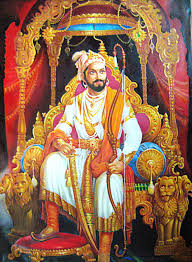The Maratha Empire also was known as the Maratha Confederacy was the dominant power in the 17th and 18th centuries. The Empire was established in 1645 and with the defeat of Peshwa Bajirao-2, it was demolished in 1818.
The empire is largely known for ending of the Mughal rule. The empire had its capital at Raigad Fort. The Empire was ruled by Chhatrapati and Peshwas. The empire was established in the region of western Deccan plateau, known as Maharashtra today. The Empire gained its significance with the Hindavi Swarjaya, which means self-rule of Hindu people.
Chhatrapati Shivaji (1627-1680)

Ever heard the name Shivaji? Well, most of us have heard about the great Indian warrior king before, but do you remember he was from the Maratha Empire? Chhatrapati Shivaji was one of the prominent rulers from the Maratha Empire. He was the reason for the Maratha Empire to become prominent in the 17th century. He built his own kingdom with Raigad as its capital.
- Shivaji established a very systematic and progressive civil rule and well-structured administration.
- He also promoted the usage of Marathi and Sanskrit in the kingdom.
- He was known for his tolerant and liberal religious policy. Hindus were relieved to follow their religion under a Hindu ruler but also allowed Muslims to practice their religion without any cultural barrier. He also had many prominent Muslims in his army.
- He also built his navy in 1657 or 1659 to maintain control over the Konkan Coast.
- He was well known for his strong religious and warrior code of ethics and an extraordinary character. He was also recognized as a great national hero during the Indian Independence Movement.
Today, Shivaji is considered as a National hero in India and always remains as the greatest figure in Maharashtra’s history.
After Shivaji, his elder son Sambhaji crowned himself as the ruler. Rajaram, the half-brother of Sambhaji ascended the throne after the death of Sambhaji. He soon fled away to Vishalgad and then to Gingee. Rajaram died in 1700 and his wife Tarabai took the control in the name of her son Ramaraja who was considered as Shivaji-2.
Shahu, son of Sambhaji was released by the new Mughal emperor Bahadur Shah-1 who ascended the throne soon after the death of Aurangzeb in 1707. Soon after the release Shahu ascended the Maratha throne and challenged his aunt Tarabai.
Shahu, in the year 1713, appointed Balaji Vishwanath as Peshwa. The Peshwa was successful in getting Shahu as the rightful heir of Shivaji. His major achievement was the “Treaty of Lonavla” in 1714 with Kanhoji Angre. After the death of Vishwanath in 1720, Baji Rao was appointed Peshwa. Baji Rao was credited for the expansion of the empire nearly 10 times. He fought over 41 battles and never lost one. The Battle of Palkhed was fought between Baji Rao-1 and Qamar-ud-din Khan, Asaf Jah-1 of Hyderabad. In the battle, Maratha defeated the Nizam with a good strategy.
Baji Rao’s son Balaji Bajirao, popularly known as Nanasaheb was appointed the next Peshwa.
The Maratha rulers encouraged agriculture and protected the villagers. Delhi was captured under Raghunath Rao, brother of Nanasaheb in 1757. They captured Peshawar. By 1760, with the defeat of the Nizam, Maratha power became strong.
The kingdom was ruled in parts as districts by the statesman and various chiefs. The semi-autonomous Maratha states were the Peshwas of Pune, Gaekwads of Baroda, Holkars of Indore, Bhonsales of Nagpur, Puars of Dewas and Dhar and Scindias of Gwalior and Ujjain.
In 1779, Yashwant Rao Holkar captured Ujjain who rebelled against the policies of the Peshwa Baji rao-2. He made a treaty with the British. Ultimately, in the Third Anglo-Maratha War (1817-1818) the Maratha lost their independence. Pune came under the direct rule of British with the exile of Peshwa to Bithoor. Gwalior, Indore, and Nagpur lost their territories and came under the rule of British.
What’s so unique about the Maratha Empire?
The history of the Maratha Empire is treated to be one of the six golden pages of Indian history which saw great warrior kings and liberators.
- Their warfare followed the idea of ‘Dharmayudh’ which means the righteous war. Their determination and desire for the victory which left other empire rulers spellbound.
- Their speed and strategy in the wars were the perfect examples for their victory.
- The “Bhakti Movement” which helped to unite the people on a nationalistic platform which provided massive support to the Shivaji’s spiritual efforts.
- The most important character of the Maratha armies was offensive all throughout the history.
- The Maratha Empire always supported equality which was not at all common in the medieval period. There were many people from low castes and Muslims from the society who played an important role in the achievement of independence from the foreign rule.
- They were the real inspiration to many other folks in the state who turned out to be the national heroes who willed to sacrifice their lives for independence.
We believe in sharing knowledge with everyone and making a positive change in society through our work and contributions. If you are interested in joining us, please check our ‘About’ page for more information
